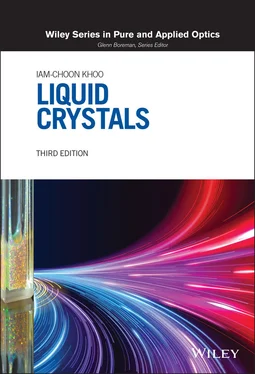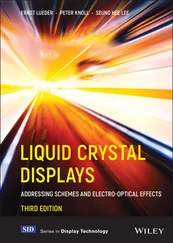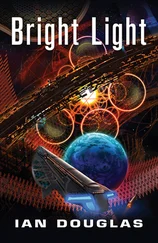Iam-Choon Khoo - Liquid Crystals
Здесь есть возможность читать онлайн «Iam-Choon Khoo - Liquid Crystals» — ознакомительный отрывок электронной книги совершенно бесплатно, а после прочтения отрывка купить полную версию. В некоторых случаях можно слушать аудио, скачать через торрент в формате fb2 и присутствует краткое содержание. Жанр: unrecognised, на английском языке. Описание произведения, (предисловие) а так же отзывы посетителей доступны на портале библиотеки ЛибКат.
- Название:Liquid Crystals
- Автор:
- Жанр:
- Год:неизвестен
- ISBN:нет данных
- Рейтинг книги:4 / 5. Голосов: 1
-
Избранное:Добавить в избранное
- Отзывы:
-
Ваша оценка:
- 80
- 1
- 2
- 3
- 4
- 5
Liquid Crystals: краткое содержание, описание и аннотация
Предлагаем к чтению аннотацию, описание, краткое содержание или предисловие (зависит от того, что написал сам автор книги «Liquid Crystals»). Если вы не нашли необходимую информацию о книге — напишите в комментариях, мы постараемся отыскать её.
Liquid Crystals,
Liquid Crystals
Liquid Crystals
Liquid Crystals — читать онлайн ознакомительный отрывок
Ниже представлен текст книги, разбитый по страницам. Система сохранения места последней прочитанной страницы, позволяет с удобством читать онлайн бесплатно книгу «Liquid Crystals», без необходимости каждый раз заново искать на чём Вы остановились. Поставьте закладку, и сможете в любой момент перейти на страницу, на которой закончили чтение.
Интервал:
Закладка:
Examples of these kinds of molecules are soaps ( Figure 1.8) and various phospholipids like those present in cell membranes. Lyotropic liquid crystals are of interest in biological studies [7].

Figure 1.8. Chemical structure and cartoon representation of sodium dodecyl sulfate (soap) forming micelles.
1.3.2. Polymeric Liquid Crystals
Polymeric liquid crystals are basically the polymer versions of the monomers discussed in Section 1.1. A good account of polymeric liquid crystals may be found in [9]. There are three common types of polymers, as shown in Figure 1.9a–c, which are characterized by the degree of flexibility. The vinyl type ( Figure 1.9a) is the most flexible, the Dupont Kevlar polymer ( Figure 1.9b) is semirigid, and the polypeptide chain ( Figure 1.9c) is the most rigid. Mesogenic (or liquid crystalline) polymers are classified in accordance with the molecular architectural arrangement of the mesogenic monomer. Main‐chain polymers are built by linking rigid mesogenic groups in a manner depicted schematically in Figure 1.10a; the link may be a direct bond or some flexible spacer. Liquid crystal side‐chain polymers are formed by pendant side attachment of mesogenic monomers to a conventional polymeric chain, as depicted in Figure 1.10b.

Figure 1.9. Three different types of polymeric liquid crystals: (a) vinyl type; (b) Kevlar polymer; (c) polypeptide chain.
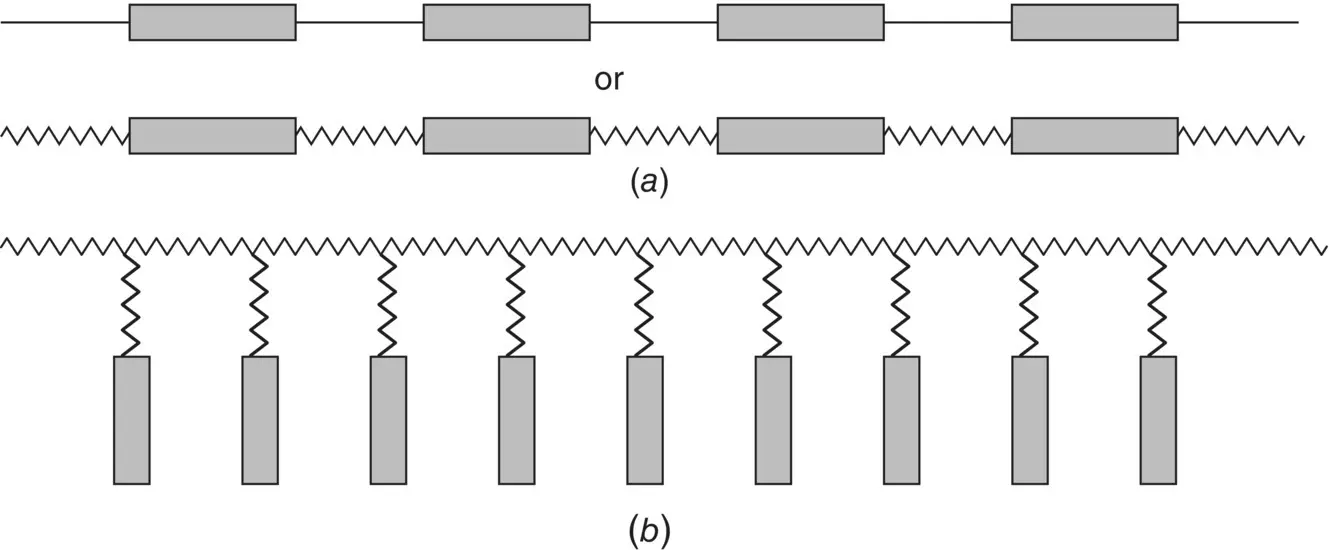
Figure 1.10. Polymeric liquid crystals: (a) main chain; (b) side chain.
1.3.3. Thermotropic Liquid Crystals: Smectic, Nematic, Cholesteric, and Blue‐phase Liquid Crystals
Although the molecular structures of thermotropic liquid crystals are quite complicated, they are often represented as “rigid rods” that interact with one another to form distinctive ordered structures (or phases) as a function of ascending temperature: crystals, smectic, nematic, cholesteric (including blue‐phase), and the isotropic liquid phase. In smectic liquid crystals, there are several subclassifications in accordance with the positional and directional arrangement of the molecules.
As explained in greater detail in the following chapters, these mesophases are defined and characterized by many physical parameters such as long‐ and short‐range order, orientational distribution functions, and so on. Here we continue to use the rigid‐rod model and pictorially describe these phases in terms of their molecular arrangement.
Figure 1.11a depicts the collective arrangement of the rodlike molecules in the nematic phase schematically. These molecules are, however, directionally correlated; they are aligned in a general direction defined by a unit vector ñ , the so‐called director axis, which may be regarded as the crystal axis. Nevertheless, the molecules are positionally random and exhibit flow very much like liquids; X‐ray diffraction from nematics does not exhibit any diffraction peak.
Although individual molecules of nematic liquid crystal (NLC), cholesteric liquid crystal (CLC), and blue‐phase liquid crystal (BPLC) may be polar, i.e. carry a permanent dipole, they tend to self‐assemble themselves in such a manner that bulk liquid crystals are centrosymmetric, cf. Figure 1.12; their physical properties are the same in the  and the optically uniaxial
and the optically uniaxial  directions.
directions.
Cholesteric liquid crystals, often also called chiral nematic liquid crystals, resemble nematic liquid crystals except that the molecules assembled in a helical manner, as depicted in Figure 1.11. This property results from the addition of chiral agents to nematic constituents in the starting mixture. Owing to the spatially (helical) varying refractive index, CLCs possess special optical properties such as photonic bandgaps for transmission of circularly polarized lights. More details on CLC as well as cholesteric BPLCs obtained by increasing the concentration of the chiral constituent [10] in the starting mixture are presented in Chapter 4.
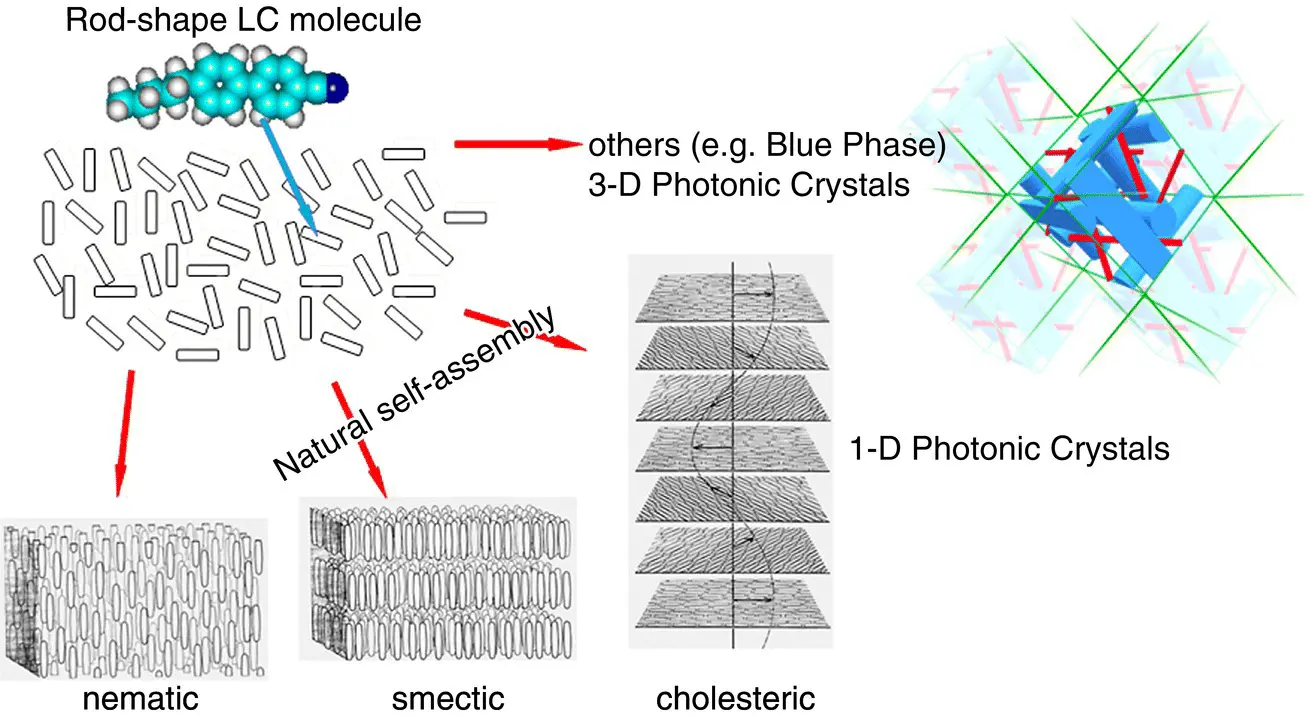
Figure 1.11. Self‐organization of the rod‐shaped LC molecules via local and long‐range order giving rise to various ordered phases of liquid crystal.

Figure 1.12. Arrangement of dipoles in the centrosymmetric bulk crystal such as nematics.
Smectic liquid crystals, unlike nematics, possess positional order; that is, the position of the molecules is correlated in some ordered pattern. We discuss here three representative ones: smectic‐A, smectic‐C, and smectic‐C *(ferroelectrics) due to their relevance to optical and photonic studies/applications noting that many other subphases of smectics such as smectic G, H, I, F…Q with different molecular arrangement and orders have been identified.

Figure 1.13. Molecular arrangements of liquid crystals: (a) smectic‐A; (b) smectic‐C; (c) smectic‐C *or ferroelectric; (d) unwound smectic‐C *.
Figure 1.13a depicts the layered structure of a smectic‐A liquid crystal. In each layer, the molecules are positionally random but directionally ordered, with their long axis normal to the plane of the layer. Similar to nematics, smectic‐A liquid crystals are optically uniaxial; that is, there is a rotational symmetry around the director axis.
The smectic‐C phase is different from the smectic‐A phase in that the material is optically biaxial, and the molecular arrangement is such that the long axis is tilted away from the layer normal  (cf. Figure 1.13b).
(cf. Figure 1.13b).
In smectic‐C *liquid crystals, as depicted in Figure 1.13c, the director axis  is tilted away from the layer normal
is tilted away from the layer normal  and precesses around the
and precesses around the  axis in successive layers. This is analogous to cholesterics and is due to the introduction of optical‐active or chiral molecules to the smectic‐C liquid crystals.
axis in successive layers. This is analogous to cholesterics and is due to the introduction of optical‐active or chiral molecules to the smectic‐C liquid crystals.
Smectic‐C *liquid crystals are interesting in one important aspect; namely, they comprise a system that permits, by the symmetry principle, the existence of spontaneous electric polarization. This can be explained simply in the following way. The spontaneous electric polarization  is a vector and represents a breakdown of symmetry; that is, there is a directional preference. If the liquid crystal properties are independent of the director axis
is a vector and represents a breakdown of symmetry; that is, there is a directional preference. If the liquid crystal properties are independent of the director axis  direction (i.e.
direction (i.e.  is the same as
is the same as  ),
),  , if it exists, must be locally perpendicular to
, if it exists, must be locally perpendicular to  . In the case of smectic‐A, which possesses rotational symmetry around
. In the case of smectic‐A, which possesses rotational symmetry around  ,
,  must therefore be vanishing. In the case of smectic‐C, there is a reflection symmetry (mirror symmetry) about the plane defined by the
must therefore be vanishing. In the case of smectic‐C, there is a reflection symmetry (mirror symmetry) about the plane defined by the  and
and  axes, so
axes, so  is also vanishing. This reflection symmetry is broken if a chiral center is introduced to the molecule, resulting in a smectic‐C *system.
is also vanishing. This reflection symmetry is broken if a chiral center is introduced to the molecule, resulting in a smectic‐C *system.
Интервал:
Закладка:
Похожие книги на «Liquid Crystals»
Представляем Вашему вниманию похожие книги на «Liquid Crystals» списком для выбора. Мы отобрали схожую по названию и смыслу литературу в надежде предоставить читателям больше вариантов отыскать новые, интересные, ещё непрочитанные произведения.
Обсуждение, отзывы о книге «Liquid Crystals» и просто собственные мнения читателей. Оставьте ваши комментарии, напишите, что Вы думаете о произведении, его смысле или главных героях. Укажите что конкретно понравилось, а что нет, и почему Вы так считаете.
